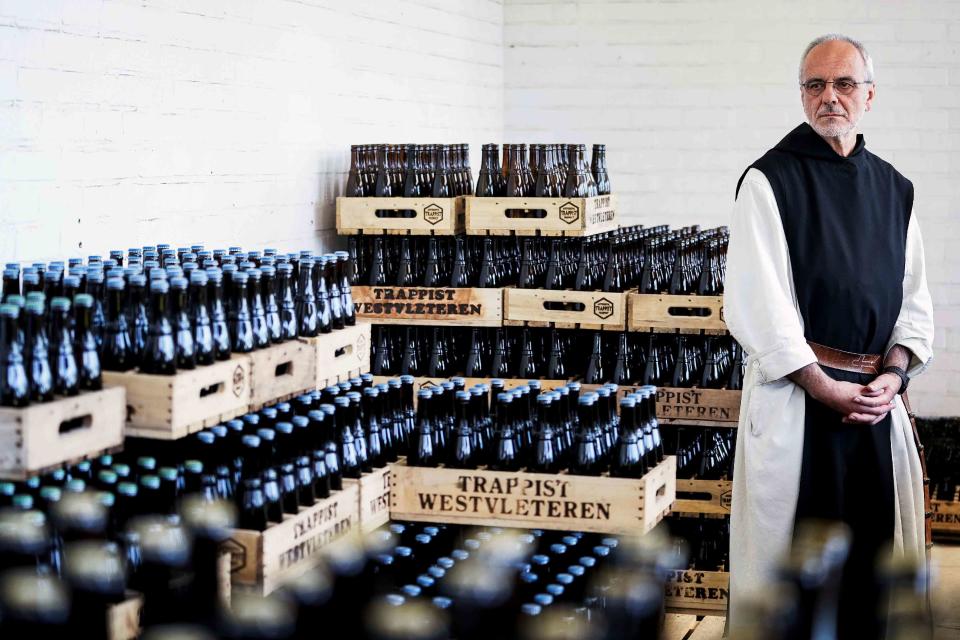Beer Lovers Shouldn't Lose Faith in Trappist Breweries Just Yet
With recent closures and only a dozen or so authentic Trappist breweries still operating, is their future hazy or bright?

Kenzo Tribouillard / AFP via Getty Images
In an era dominated by lagers, hazy IPAs, and non-alcoholic beers, Trappist brews have remained a small, but quintessential part of the global craft beer experience. Even as their existence is threatened due to factors like the rising costs of ingredients and an aging workforce, the handful that remain continue to churn out some of the most iconic beers in the world.
The number of Trappist breweries in operation around the world tends to fluctuate, but there are typically never more than thirteen or so at a given time. The majority are located in Belgium: Bières de Chimay, Brouwerij der Trappisten van Westmalle, Brouwerij Westvleteren, Brasserie de Rochefort, and Brasserie d'Orval. Brouwerij de Koningshoeven (La Trappe) and Brouwerij Abdij Maria Toevlucht (Zundert) are located in the Netherlands, Tre Fontane is Rome’s only Trappist brewery, and England’s Mount St Bernard Abbey (Tynt Meadow) rounds out the bunch.
A few have fallen in recent years — Stift Engelszell in Austria is in the process of dissolution, and the United States’ only Trappist brewery ever to exist, Spencer Brewery, shuttered in 2022 after eight years of operations. In 2021, the International Trappist Association (ITA) revoked Achel Abbey’s official Trappist brewery title when the last two monks transferred to Westmalle.
What is Trappist beer?
Manu Pauwels, head of marketing at Westmalle and ITA spokesperson, is quick to point out that “Trappist” beer is not a style — rather, it’s a designation that must meet three conditions to be considered authentically Trappist by the ITA.
“It is brewed in a Trappist abbey, [and] it is produced entirely under the control of the Trappist monks of that abbey,” he says, explaining that “Trappist” is the common name referring to the monastics belonging to the Order of Cistercians of Strict Observance. “[Third], the revenue serves for the sustenance of that abbey community and to support charitable causes.”
In short, it must be brewed in a recognized Trappist abbey, under the purview of monks (but not necessarily brewed by the monks), and they must be a self-sustaining business enterprise that gives away any proceeds — not otherwise required by the abbey to function — to charity.
It also must hit one more important, but subjective provision: quality. “Because the pursuit of growth is virtually irrelevant, there can just be a lot of focus on that quality,” explains Pauwels. “There are no cuts in time and resources if this would affect the product itself.”
Not only do they have the time to aim high, they have a divine responsibility to do so, says Professor Doug Miller at Cornell University, “If they're going to do something, they want it to be the highest quality, or else it would go against their religious teachings.”
Related: The 25 Most Important American Craft Beers Ever Brewed
A brief history of Trappist breweries...
Once upon a time, abbeys were safe places for ascetic men to grow closer to God and provide refuge for weary travelers, explains John Staunton, Eastern US Division Manager at Merchant du Vin, a specialty beverage importer. Brewing beer became a natural part of the brothers’ chores, before water sanitation was guaranteed. “[Travelers] knew the beer was safe to drink,” says Staunton. “That tradition is what it’s turned into today.”
But the Trappist tradition of staying small and focusing on a small handful of beers — often just one beer, as in the case of Orval — can be a double-edged sword. The romantic origin story and brewing history dating back hundreds of years that many of the remaining Trappist breweries share can be difficult for new breweries, like Spencer, to duplicate in the 21st century. Plus, Trappist monasteries can undertake any commercial operation, such as dairy farming or soap making, to remain self-sustaining, and brewing can be an expensive endeavor.
On top of costs, religious institutions of all denominations are facing another crisis. “There simply aren’t enough monks anymore to keep the monasteries going indefinitely, and they’re aging out,” says Joe Stange, managing editor of Craft Beer & Brewing Magazine and co-author of Good Beer Guide Belgium. He notes that while monks are not required to execute the day-to-day operations at Trappist breweries to produce an authentic Trappist beer, they still need to supervise the work. “That can only happen for as long as there are monks and abbeys.”
Gumer Santos, brewer and quality engineer for Rochefort, admits enticing new monks is a challenge, but not an insurmountable, or even universal one. “The decreasing interest in monastic living is relative to the Occidental World,” he says. “In Asia, South America and Africa, it’s not the same.” An increase in recruits from outside Europe have helped bridge the gap in order to keep the beer flowing, but even that pipeline’s longevity remains uncertain.
Related: 16 Craft Breweries Where the Food Is as Big a Draw as the Beer
What is the future of Trappist beer?

Oli Sscarff / AFP via Getty Images
Despite economic and religious challenges, Trappist beer (probably) isn’t going anywhere, at least not anytime soon. Several breweries like Chimay, Westvleteren, and Westmalle have been around for over 150 years and are still going strong. With that legacy to rely on, Staunton is optimistic about an ongoing future, even as consumer tastes evolve from the “big Belgian beer” mania of the ‘90s to today’s “drink as fresh as possible” movement.
“When someone is told over and over by their local brewers to drink beer that day, and then they find something with a five year shelf life, like Orval, they might look at it cross-eyed,” he laughs. “The whole industry has to do a better job of education and bringing this to the new drinker. If you’re 21 years old and somebody throws an Orval at you, you’re not going to know what to do with it!” He points to initiatives like Orval Day and Trappist Tuesday as efforts to bring fresh initiates to the Trappist tradition.
For Pauwels and Westmalle, education at the consumer level does not mean evolution on the production side. “We are convinced that we do not need to adapt our beers to survive,” he says. Still, he adds, it probably wouldn’t hurt for breweries to put themselves out there a bit more. “Trappist breweries are not in the habit of communicating much. Consequently, you can't blame consumers for not knowing much about Trappist beer.”
Stange hopes these measures will be enough to ensure monastic brewery culture continues. Even still, that’s still no reason to take the existence of Trappist beer for granted. “We shouldn’t assume they’ll be around forever,” he muses. “Let’s enjoy those earthly delights while we can.”
For more Food & Wine news, make sure to sign up for our newsletter!
Read the original article on Food & Wine.

